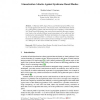10 search results - page 1 / 2 » Exploiting Coding Theory for Collision Attacks on SHA-1 |
IMA
2005
Springer
13 years 10 months ago
2005
Springer
In this article we show that coding theory can be exploited efficiently for the cryptanalysis of hash functions. We will mainly focus
SECRYPT
2007
13 years 6 months ago
2007
Lately, hash function security has received increased attention. Especially after the recent attacks that were presented for SHA-1 and MD5, the need for a new and more robust hash...
ISW
2009
Springer
13 years 11 months ago
2009
Springer
The recently started SHA-3 competition in order to find a new secure hash standard and thus a replacement for SHA-1/SHA-2 has attracted a lot of interest in the academic world as ...
INDOCRYPT
2007
Springer
13 years 10 months ago
2007
Springer
Abstract. In MyCrypt 2005, Augot, Finiasz, and Sendrier proposed FSB, a family of cryptographic hash functions. The security claim of the FSB hashes is based on a coding theory pro...
MYCRYPT
2005
Springer
13 years 10 months ago
2005
Springer
Recently, some collisions have been exposed for a variety of cryptographic hash functions [20,21] including some of the most widely used today. Many other hash functions using simi...

